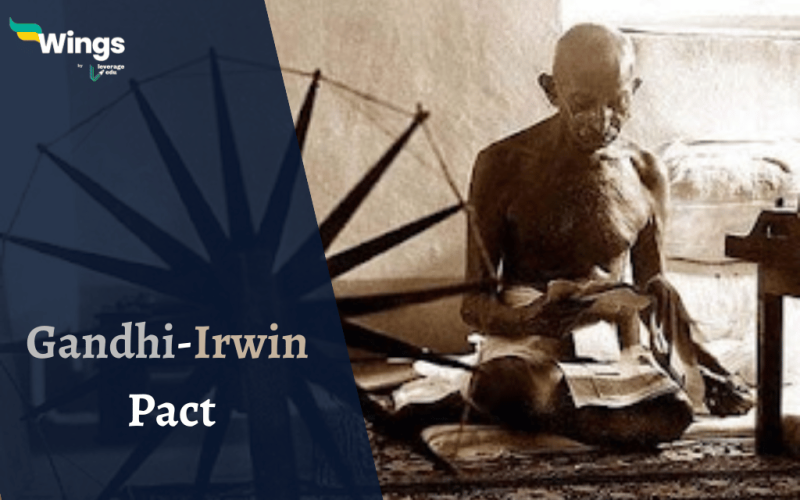On the 5th of March 1931, a historic pact was signed between Mohandas Karam Chandra Gandhi and Lord Irwin. Gandhi and his followers launched a civil disobedience movement against the British government in 1930. It started with the famous salt satyagraha march to Dandi. The Gandhi-Irwin pact is known to mark the end of civil disobedience with a pact signed between Gandhi and Irwin.
Background
Table of Contents [show]
The civil disobedience movement was fuelled by the arrest of Mahatma Gandhi for illegally making salt. However, by the end of 1930 thousands of Indians were in jail for following civil disobedience. All this was happening as the British refused to address the 11 demands put forth by Gandhi in the first round table conference. The main problem for the British here was that the movement gained worldwide popularity. Hence, Lord Irwin was searching for ways to end it.

Also Read: The Vellore Mutiny of 1806
Conditions Suggested By Indian National Congress
The Indian National Congress (INC) has suggested certain conditions. These include the following
- INC suggested the release of political prisoners who were imprisoned during the Civil Disobedience Movement. The unconditional release of the prisoners was demanded to indicate that the British government was willing to negotiate.
- Removal of salt tax and recognition of the right to produce salt. This was a symbolic demand.
- Remove all the restrictions on civil liberties, and abolish repressive laws. For example, laws that prohibit the freedom of the press, speech, and assembly.
- Return the properties that were confiscated during the Civil Disobedience movement
- Finally, recognizes INC as a political entity.
Conditions Suggested by the British Government
The British government also suggested conditions. These are as follows:
- Cooperation from the INC to ensure that the movement does not escalate.
- Suspending the civil disobedience movement, and protest against the British government.
- Lord Irwin wanted INC to take part in the Second Round Table Conference held in London. This was to discuss the constitutional reforms, and the governance of India in the future.
Features of Gandhi-Irwin Pact
Considering the fate of thousands of Indians, the INC agreed to take part in the round table conference. These are the features of the Gandhi-Irwin Pact;
- The civil disobedience was suspended indefinitely.
- The ordinances that curbed the working of Congress were to be lifted.
- Locals were allowed to make their own salt for domestic usage from the seawater without tax.
- All prisoners of the civil obedience movement will be released.
- Gandhi’s proposal to revoke Bhagat Singh’s death sentence was turned down.

Also Read: What Was Subsidiary Alliance? Get Complete Results, Policies & Notes to Prepare
Outcomes of Gandhi-Irwin Pact
The following were the outcomes of the Gandi-Irwin Pact;
- INC participated in the second round table conference.
- The government allowed foreign cloth and liquor shops.
- The ban on INC was lifted to hold peaceful non-anti-establishment meetings.
- Confiscated properties of satyagrahis were released.
- The British were outraged by the ideologies of the pact.

Also Read: Bardoli Satyagraha- A Historic Struggle for Justice
Demands Unaccepted by Irwin
Although negotiations took place, Lord Irwin maintained his stance. Only a few demands were accepted. The other demands were unaccepted. Some of these demands that were not accepted are as follows-
- Gandhi’s demand to reduce the death sentence to a life sentence given to Sukhdev, Bhagat Singh, and Rajguru was also not accepted.
- Public inquiry regarding the police activities for the suppression of the movement
Significance
Let’s highlight the significance of the pact in shaping a route for India’s independence.
- Gandhi’s quest for independence through a non-violent way of satyagraha was highlighted in the process.
- This was the second high-level meeting of its kind between Gandhi and a high-level viceroy. Such a meeting was held after 13 years.
- Negotiations between the British and the Indian National Congress were initiated for the first time. It laid the foundation for future discussions and constitutional reforms.
FAQs
The main outcome of the Gandhi-Irwin Pact was the release of political prisoners. These prisoners were arrested during the Civil Disobedience Movement. This symbolised agreement with the Indian demand.
This was a political agreement signed between Lord Irwin and Mahatma Gandhi. The Gandhi- -Irwin Pact of 1951 was a compromise between the Indian nationalists and the British. The aim was to end the Civil Disobedience movement.
The Viceroy Irwin or Edward Frederick Lindley Wood was the Viceroy of Indian. The was the Vicery from 1926 to the year 1931.
The Salt Satyagraha was a non-violent protest held against the British (1930). This was an act of civil disobedience. Mahatma Gandhi led this movement against the salt tax.
The civil disobedience movement was discontinued. Moreover, Gandhi agreed to take part in the second round table conference. This was as per the political agreement singed by Irwin and Mahatma Gandhi.
The conference was attended by Gandhi due to several reasons. For example, the Gandhi-Irwin Pact was signed. The Gandhi-Irwin pact led to the release of political prisoners and the end of cthe ivil disobedience movement.
Relevant Blogs
| Birsa Munda: Life and his Ulgulan Movement | Henry Vivian Derozio |
| Tribal Movement in India | Poona Pact |
| Peasant Movements in India | Indigo Rebellion |
| Santhal Rebellion | Rani Gaidinliu and The Heraka Movement |
This blog was all about the Gandhi Irwin Pact. If you want to read more articles like this, you can get Short notes on the Modern History of India here. Also, you can visit our general knowledge page on Indian History!
 One app for all your study abroad needs
One app for all your study abroad needs















 45,000+ students trusted us with their dreams. Take the first step today!
45,000+ students trusted us with their dreams. Take the first step today!
